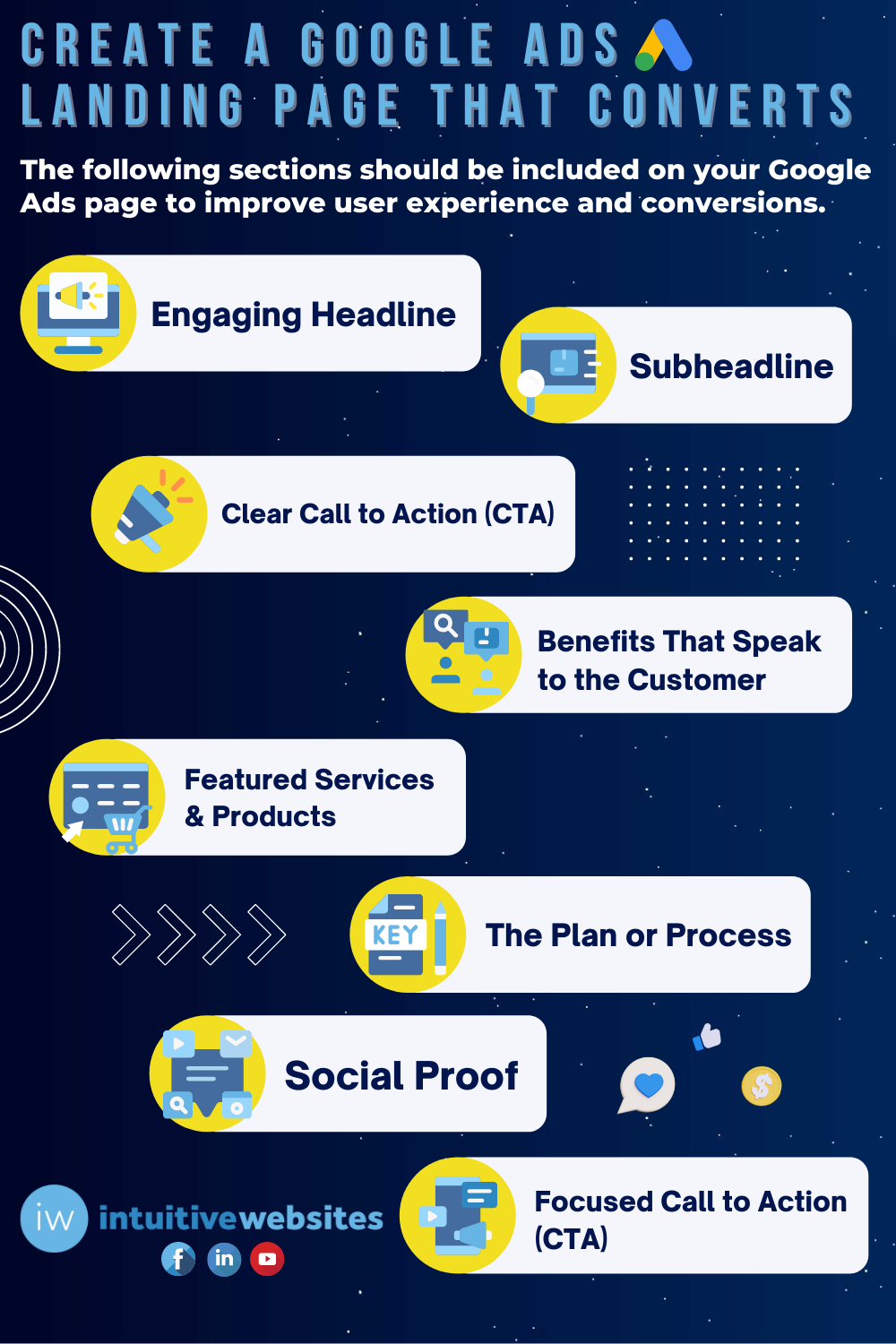Google Ads are a great way to supplement SEO traffic and to get targeted visitors to your website. However, it’s easy to spend money with Google quickly and not see results!
To ensure you get the most out of your investment in paid traffic to your site, it’s best to start with strategy. A key part of that includes the landing pages that are used in your Google Ads campaigns.
It’s common for marketers to send Google Ads traffic to the website homepage or other pages on the site, however this is not as effective as using a dedicated landing page.
In today’s post we’ll dig into the Google Ads landing page experience and why this is key to Google Ads success. We’ll explore what components to include on your Google Ads landing page, so that your investment turns website visitors into clients and customers.
New to Google Ads? Check out our free guide for a Winning Formula for Success with Google Ads here.
What is a Google Ads Landing Page?
A “landing page” is a page on your website that a visitor goes to after they click on a Google Ad.
For this to be successful, the landing page should meet the exact needs of the Google Ads visitor. Consider the intent of the keywords someone puts in Google search, the results they see, and the page they go to after clicking on one of your Google Ads.
The farther the searcher is in the sales process, the more specific their searches tend to be, and the more specific the landing page should be.
If someone is searching on Google for a specific product or service that you offer and they are directed to your website’s homepage, then they will likely have to search again for what they were looking for.
Since many people are lacking patience these days, or could be confused about where to go next on your homepage, they are more likely to bounce out and click back to the Google search results.
When you lead the user to a specific landing page that matches their search query, they are much more likely to stick around and learn more. To improve conversions from your ads, take that user to a landing page about that specific product or service and make it easy for them to take the next steps.
Considering Google Search Intent
When someone clicks on your Google Ad they have a clear search intent. If they are searching for “rental properties in Florida”, for example, they don’t want to see rental properties in California or in other states.
In order for your Google Ads campaigns to be successful, it’s important to consider the search intent behind the keywords you bid on, the ad the searcher sees, and the page people land on after clicking on your ad.
To improve conversions, the journey throughout should be clear, consistent, and specific to the intent of the user.
Informational Intent
Is the searcher at the beginning of the sales funnel, in a researcher stage, and using keywords with informational intent? If so, it may make sense to send them to a landing page that offers them a free eBook or some other helpful resource in exchange for their email address.
This will help provide a solution to their informational needs, get them into your sales funnel, and introduced to your brand. Email follow up will help keep you top of mind, so they know who to turn to when they are ready to take the next steps.
Local Intent
If the searcher is using terms like “near me”, they usually have intent to visit your location. Make sure your location and contact information are easy to find on your landing page.
If your goal with your Google Ads is to get people into your store, include directions and a Google Map on the landing page. Also, make sure to take advantage of Google Ads local ad extensions.
Transactional Intent
People searching for transactional type keywords are looking to purchase one of your products or services. Lead them to a page that makes it easy for them to do that.
Make it clear what the next step is on your landing page with a call to action (CTA). Make sure that CTA is consistent with what’s in your Google Ads. Make it easy for the user with clear instructions on how to buy or contact you.
Consistent Special Offers
Are you offering an incentive in your ad like free shipping, free estimates or a free consultation? Make sure that’s mentioned on your landing page too.
There should be no surprises for the user. Make sure the page and offers match what’s being shown in your Google Ads.
Landing Page vs. Squeeze Page
To note: A landing page is not a “squeeze page”. A squeeze page is a digital marketing term for a web page where there is no main navigation, but rather a single page that has a clear call to action for the user to take, and they either take it or leave.
While squeeze pages can produce higher conversion rates, we do not recommend them for Google Ads, since Google generally grades squeeze pages with a poor user experience. This means your ads won’t show as often and you’ll pay higher costs per click.
Google’s goal is to provide its users with the right, relevant content, and they reward advertisers that lead users to a more robust website with a main navigation. Thus, when it comes to Google Ads, it’s best practice to lead people to a landing page on your website over a squeeze page.
This doesn’t mean, however, that you should just send visitors to your homepage. Since you are paying for traffic with Google Ads, it’s important that your landing page is designed to meet the needs of that individual searcher and drive conversion for your business or organization.
Tracking Google Ads Conversions
If you have an ecommerce site a conversion would be a sale. If the goal of your website is lead generation, then a conversion would be a form completion, email or phone call.
It’s important to measure conversion with your Google Ads campaigns so that you can measure ROI and opportunities for further conversions.
How to Optimize Google Ads Landing Page Experience
Target your campaigns.
To improve user experience, each of your Google Ads campaigns should have their own targeted landing page and include targeted keywords and focus for that campaign. Consider the keywords that you’re targeting and the intent behind them. Where is the user in the sales funnel? Make sure you’re leading them to the right type of landing page for their search.
Be direct and specific to the search.
The more specific and direct you can make the experience between the search query, Google Ad, and landing page, the better the chances your page will convert.
Include targeted keywords in headlines.
It’s best practice with Google Ads landing pages to include the primary keywords you’re targeting in easy to see headlines and copy throughout the page.
Build trust with the user.
Trust is built when a visitor lands on a page that fulfills their search query. They should know right away that they’ve landed in the right spot. Building trust with the user leads to more conversions and higher quality scores with Google, which means your ads will show more often, at a lower cost per click.
Include verbiage from the ads.
It’s a good idea to include the same verbiage from your Google Ads on the landing page so that trust is further built. If a special offer is promoted in the ad, make sure there is mention of it on the landing page with clear instructions on how to obtain it.
Don’t forget about mobile.
Make sure your landing pages are mobile responsive and load fast. The last thing you want is to lose traffic you’re paying for because your site is too slow to load!
Consider live chat.
Did you know that websites that include a live chat option see a greater number of Google Ads conversions? Having a live agent (or the appearance of one with today’s many AI choices) quickly builds trust with the user. It makes it easy to qualify the visitor and point them in the right direction. Sites with live chat consistently see increases in other conversion activities such as sales, form fills and phone calls.
How to Create a Google Ads Landing Page that Converts
The following sections should be included on your Google Ads page to improve user experience and conversions.
Engaging Headline that includes the primary keyword(s) for the campaign
Subheadline that speaks to the prospective customers and what’s in it for them.
Clear Call to Action (CTA) including the option to buy, contact or sign-up. What do you want them to do at this point in the sales funnel.
Benefits that speak again to what is in it for the customer. How do your services benefit them? Why should they choose you?
Featured Services and Products including the value proposition of your business or organization and be sure to include keywords that you’re targeting.
The Plan or Process that sets your business apart from the competition. What are the next steps? A video could go here.
Social Proof such as customer testimonials, industry logos or awards, case studies or list of notable clients served.
Focused Call to Action (CTA) including the option to buy, contact or sign-up, depending on what action you’d like the user to take. The landing page should have one focused CTA and it should be clear to the user what action they should take next and easy for them to do so.
Need More Help Increasing Conversions with Your Google Ads Campaigns?
To get started, set up an initial meeting or phone call with our team to evaluate your needs and determine if there is a good fit. We are happy to sign a non-disclosure and review your current marketing efforts for free. Following our initial discussion, we can prepare a customized proposal for your team.





